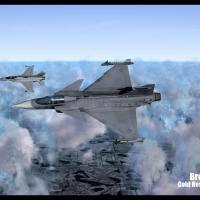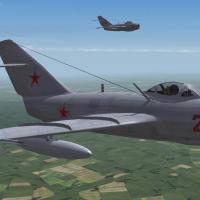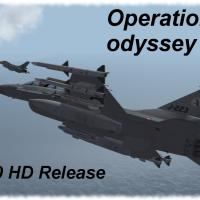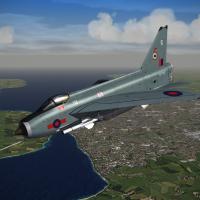-
Content count
133 -
Joined
-
Last visited
Content Type
Profiles
Forums
Calendar
Gallery
Downloads
Store
Everything posted by fireengineer
-

The Scandinavian Front Mega Package Part 1
fireengineer reviewed JonathanRL's file in User Made Campaigns
-

The Scandinavian Front Mega Package Part 2
fireengineer reviewed JonathanRL's file in User Made Campaigns
-

SF2: Modern Warfare Korea V1.03 Part1
fireengineer reviewed Spectre8750's file in User Made Campaigns
-

Updated munition models pack 1.21
fireengineer reviewed walmis's file in FALCON 4.0: Allied Force by MicroProse
-

Operation Odyssey Dawn 2.0 HD Part 1
fireengineer replied to Peugeot205's topic in Thirdwire: Strike Fighters 2 Series - File Announcements
There appears to be no sound folder in the version I downloaded. -

Red Tide Soviet Air Force 773 IAP MiG-15bis
fireengineer commented on regula50's file in User Made Campaigns
-

Operation Odyssey Dawn 2.0 HD Part 1
fireengineer commented on Peugeot205's file in User Made Campaigns
-

Operation Stamford Bridge; Battle of Britain 1980
fireengineer commented on JonathanRL's file in User Made Campaigns
-
Hi guys I found this on You Tube. It may be old here but here it is anyway. This a 1 hour 20 minute talk by Bob Hoover in 2010. Amazing man, amazing talk. Enjoy.
-
C'mon guys a simple yes would be nice!
-
Good, no?
-
HMS Invincible lost one of her turbines shortly after leaving England. She was at a reduced speed for the whole war after that.
-

Typhoon tries to land on Hedge
fireengineer replied to MigBuster's topic in Military and General Aviation
Epic. Used to watch the RAF Nimrods doing touch and goes at night. They would come in over a field like that one but with their 30 million candlepower search light on (mounted half way along the starboard wing), the night was turned onto midday sun as it passed overhead. Will never forget that as long as I live. -
You sir have hit the nail on the head. The F-35 is a mud mover. The USA has a good air superiority fighter in the F-22, but all those other nations buying the 35 as some sort of wonder weapon, or at least billing it as such, are in denial.
-
You are supposing a lot of things there. Reverse that and tell me how an F-35 miles from base will outfight a Su-35 that has twice the number of BVR missiles and triple the fuel? Also keep in mind the Russian missiles will out reach the Aim-120 by a large margin. The F-35 is LO but not in the class of the F-22 or the B-2, stealth will not help against lower frequency radars, the list goes on and on.
-
These are public reports made by Australian military. They are very detailed and unbiased. The F-35 has a great sales pitch but that's about all that is great about it. There are about 50 such reports, very detailed and it's bad news. I'm pretty Sure the Su-35 will never be flying anywhere near M2.0 in combat (it has neither the fuel, the time or the drag index to do so with missiles) - and flying high speed at 40k ft where the whole world saw you on radar 2 hours ago cant be that great an idea Really? Seeing the enemy at 40K and Mach 2 is one thing, getting a low and slow F-35 with 120's to hit it is another. The Russian R-77 and R-37 will have been fired minutes before the 120 can even get a solution. There are serious issues with the 35, it is a jack of all trades and master of none.
-
I have been reading up on the F-35 and it's not good. Looks like it will be the most useless fighter ever designed. After all it was a fighter designed by committee. Here is just a fraction of what I have found. Electronic Support Measures: Air combat aircraft emit radiation from jet engines, radar, JTIS/MIDSs terminal, radio transmissions. Specialised equipment in combat aircraft knows the frequencies of these transmissions and has sensors to detect them. Attempts are made to minimise emissions through a process of ‘Emission Control’ (EMCON) but these can only be partially successful. Both the JSF and the Su-35S have a full range of these sensors, and are assessed as being equally effective in ESM capability. ESA Radar X-Band: This is the primary sensor for jet fighters. The radar cross section of the F-35A is substantially lower than that of the Su-35S especially in the front sector, but the Sukhoi has sufficient power and a much larger antenna to partially overcome that difference. Both types are ‘networked’ so in a multi-ship engagement, the geometrical spread of the Su-35S flight in part negates the lower observability of the JSF by illuminating the JSF from angles where its low observability is weakest. Expect the F-35A to often get the ‘first look’, but the Su-35S flight to detect the JSF outside the range of the JSFs' BVR missiles. So where it matters, the limited low observability of the JSF provides little advantage. ESA Radar L-Band: The Su-35S will have this lower-frequency radar in its wing leading edges. The JSF is ‘stealthed’ for X-Band, not for L-Band. While the antenna size of the Su-35S L-Band radar limits its performance, there will be times when the L-Band radar detects the JSF before the X-Band radar. The JSF does not have an L-Band Radar and is assessed accordingly. Infra-Red Search & Track: There is a different approach to Infra-Red sensors. The JSF has a superb Electro-Optical Distributed Aperture System (DAS) designed to cover the sphere around the aircraft, but strongly optimised for air-to-ground operations. The Su-35S has a large aperture OLS-35 IRST optimised to scan for other aircraft at long range in its area of interest. DAS is a ‘staring array’ while the OLS-35 is a ‘scanning array’. The difference in detection range is like the difference between a person searching with a naked eye compared with another searching with a telescope. If the telescope is pointed in the right direction, it will get first detection. Add to that the factor that the JSF has the hottest engine in the market, and the IRST of the Su-35S is assessed as a superior aid to air combat. Identification: Not much need to be said here. The threat of fratricide in BVR air combat has led to the development of identification systems that will reliable separate friend from foe. Fratricide still happens though, especially in mixed, close-in fights. Engagement: Mach on Entry: High Mach increases the energy of BVR missiles, sending them further. The design top speed of the Su-35S is 2.25, limited by canopy and radome heating, so it has surplus power and the fuel to burn to sustain high Mach numbers. The drag of the external stores is likely to reduce this to something below Mach 2, but the missiles are cleared for launch at all speeds. The JSF has yet to demonstrate a flight above Mach 1.05, but even if it reaches its design speed of Mach 1.6, it is clearly inferior. Altitude on Entry: Like Mach, a higher altitude adds potential energy to BVR missiles, sending them further, while an enemy’s missiles must ‘climb the hill,’ severely reducing range. A second factor is that missiles fired from a higher altitude have less drag, again increasing range. The JSF is optimised for Strike missions flown at about 15-25,000 feet, while the Su-35S is optimised for air combat missions at about 40,000 feet and above, with a combat ceiling close to 60,000 feet. Points go to the Su-35S on operating altitude. Missile Range: The RVV-SD and the AIM-120D have roughly equivalent ranges, but when the RVV-SD has a high-Mach, high-altitude launch; it will outrange the AIM-120D. The Su-35S is assessed at delivering a longer BVR engagement range. This area of superiority will be increased once the RVV-AE-PD ramjet missile becomes operational. In addition, the Su-35S can carry the very long range R-37 and R-172 missiles, with ranges to 200 nautical miles. Missile Seeker Diversity: The AIM-120D currently has an active radar seeker, while the RVV-SD/R-77ME and the R-77TE have active and infra-Red (IIR) seekers respectively. Mixed sensor seekers complicate defences, for example, the F-35 may turn to defeat an active seeker and expose a hot part of the aircraft to an IR seeker. Russian doctrine is to ‘pair’ missiles with an active seeker followed by a IR seeker, creating diversity in the fight and creating ‘kill’ opportunities. The Russian missiles also have the option of passive anti-radiation seekers, designed to home on X-band radar. This diversity in missile seeker sensors gives an advantage to the Su-35S. Signature Exposure: This is a factor that primarily affects the JSF, known to have a ‘Pacman’ radar cross-section at X-Band, with a Low Observability ‘notch’ at the front. As it manoeuvres, it can turn the notch away from an aircraft searching sensor, and expose a higher radar cross-section to that search, or expose a broadside or rear-side to another aircraft. The F-35 relying on a ‘can’t see me, can’t kill me’ capability, has more to lose in a spread, manoeuvring engagement than the Su-35S, which will generally be detectable by the JSF for most of the engagement. This exposure can occur, for example, when the JSF is guiding a missile and turns away to reduce the closure rate, thereby exposing both the aircraft and an incoming missile to longer range detection, or detection from a widely spaced wingman. As the JSF is reliant on signature reduction for survival, it has more to lose if its signature increases, so is assessed as more vulnerable in the dynamics of a multi-ship, networked, turning engagement where signature management is very difficult. Endgame Electronic Countermeasures (ECM): The ‘modus operandi’ of stealth aircraft is not to radiate, or return radiation, which is the way ECM countermeasures work. Su-35S has ECM, JSF does not, except for intended AESA Radar jamming modes across a limited forward cone of about 120 degrees. ECM based on Digital Radio Frequency Memory (DRFM) can be very effective, especially against missiles with limited processing power and time to resolve targets. The Su-35S also has several ECM modes. The JSF is assessed as inferior, because it does not employ ECM to defeat attack. Decoys Towed / Fired: The Su-35S has the option of deploying towed decoys to lure a closing missile away from the body of the aircraft. The JSF approach is different, with small ‘Gen-X’ active decoys being fired as a missile closes. These measures are assessed as being approximately equivalent, with the towed decoys which are at co-speed to the target likely to present the more effective countermeasure. Flares and Chaff: These are outmoded countermeasures, but still add to the difficulty of guiding a missile to close proximity of an airframe. The GSh-301 is claimed to have rounds that fire chaff forward of the aircraft, so chaff-discrimination processing in a closing missile might be deceived. Nonetheless, the countermeasures are assessed as equivalent. Mach for a Tail-Chase / Fuel Reserves for Afterburner: At some time in a fight, an aircraft has to depart, for example when ‘Winchester’ or out of ammunition, or ‘Bingo’ or down to just enough fuel to get home. Then the fight becomes a tail-chase. The Su-35S with its higher Mach can close on a JSF, the reverse is not the case. The ability of the Su-35S to carry large fuel loads, and the prodigious consumption of the JSF F135 engine in maximum afterburner exacerbates this perilous situation for the JSF. The advantage is with the Su-35S in these aspects of engaging in a fight when the JSF is attempting to disengage. Disengagement: This is one of the under-assessed areas of future air combat. When missiles of roughly equivalent range are fired, they travel for over 100 seconds to the target. This transit time provides an opportunity for countermeasures to defeat the attack. Missile motor launch-flares are intensive and difficult to hide from Infra-Red sensors, so in many engagements, there will be early warning of an incoming missile. Active seekers ‘light-up’ at about 10 nautical miles from the target, still providing valuable warning time. Here is a range of disengagement measures: Airframe Agility: Once warned of a launch, the defending aircraft can sometimes defeat the attack by rapidly turning away to force the missile into a tail-chase. Antenna Coverage: AESA radars like the JSF APG-81 working from a fixed back-plate cover a cone of about 120 degrees. The Su-35S has an ESA radar working from a gimballed ‘swash-plate’ that covers about 240 degrees around the nose, and there is a second radar in the ‘stinger’ albeit with less capability, to cover the remainder of the sphere. If the Su-35S and the JSF fire a BVR missile at the same time and at maximum range, the Su-35S can turn away to about 120 degrees off the line joining the two aircraft, while the JSF is constrained to about 60 degrees. This runs the JSF into the Su-35S’s missile, while the Su-35S is running away from the JSF’s missile. The result could be an RVV-SD hit and an AIM-120 miss. Points to the Su-35S on this aspect. Mach on Egress / Fuel Reserves for Afterburner: This is an extension of the antenna coverage capability, as the Su-35S can accelerate away from the incoming missile, forcing it to drop-short. The JSF does not have this performance and is assessed as inferior.
-

Anybody tried SF2 on 3D TV?
fireengineer replied to Monty CZ's topic in Thirdwire: Strike Fighters 2 Series - General Discussion
I have been playing with Nvidia 3D setup for years. works very well. -

EF2000 Typhoon
fireengineer posted a topic in Thirdwire: Strike Fighters 2 Series - General Discussion
Does anyone know if the FM on the Typhoon was ever fixed to sort out the twitching of wing leveler whilst supersonic and light load? -

SF2: Modern Warfare Taiwan V1.01 Part 1
fireengineer commented on Spectre8750's file in User Made Campaigns
-

[What-if] Lockheed Martin F/A-16E Silver Falcon
fireengineer commented on DoctorWho's file in What If Hangar
-











